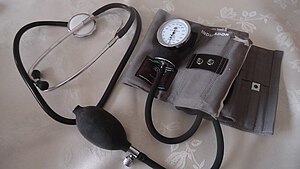Blood pressure determination
In medicine and physiology, blood pressure determination is "techniques for measuring blood pressure."[1] An elevated blood pressure may be due to hypertension. A reduced blood pressure may be due to shock.
Blood pressure determination may be inaccurate if a cuff of the wrong size is used, but home meters usually have only one size, and offices do not always substitute. A "thigh" cuff may be needed, for example, to get an accurate measurement from the upper arm of a muscular athlete or manual worker.
A systematic review by the Rational Clinical Examination has reviewed the research on blood pressure determination.[2]
Examiners with reduced hearing may be less accurate.[3]
Ambulatory monitoring may be the best method of blood pressure determination.[4]
Automated blood pressure determination
Automated blood pressure determination may reduce detection of white coat hypertension.[5] However, many automated meters have not been validated.[6]
Automated devices that average 5 readings over 10 minutes may be better.[5]
Clinical practice guidelines from the American Heart Association discuss automated determination:[7]
- "a properly maintained mercury sphygmomanometer be used for routine office measurements. There is a role for other types of devices, both as a substitute for the traditional mercury readings (e.g., aneroid and hybrid sphygmomanometers), and as supplements to them (e.g., oscillometric automatic devices). Mercury sphygmomanometers are necessary for evaluating the accuracy of any type of non-mercury device."
- "only those devices that have passed standardized validation tests should be used in practice, and oscillometric monitors should be validated on each patient before the readings are accepted"
Veterinary medicine
A pediatric cuff applied to a cat's tail can be used to get a manual systolic-only reading. Doppler techniques are used when both systolic and diastolic are needed.
References
- ↑ Anonymous (2024), Blood pressure determination (English). Medical Subject Headings. U.S. National Library of Medicine.
- ↑ Reeves RA (1995). "The rational clinical examination. Does this patient have hypertension? How to measure blood pressure". JAMA 273 (15): 1211–8. DOI:10.1001/jama.1995.03520390071036. PMID 7707630. Research Blogging.
- ↑ Song S, Lee J, Chee Y, Jang DP, Kim IY (2014). "Does the accuracy of blood pressure measurement correlate with hearing loss of the observer?". Blood Press Monit 19 (1): 14-8. DOI:10.1097/MBP.0000000000000016. PMID 24361920. Research Blogging.
- ↑ Hodgkinson J, Mant J, Martin U, Guo B, Hobbs FD, Deeks JJ et al. (2011). "Relative effectiveness of clinic and home blood pressure monitoring compared with ambulatory blood pressure monitoring in diagnosis of hypertension: systematic review.". BMJ 342: d3621. DOI:10.1136/bmj.d3621. PMID 21705406. PMC PMC3122300. Research Blogging.
- ↑ 5.0 5.1 Myers MG, Godwin M, Dawes M, Kiss A, Tobe SW, Grant FC et al. (2011). "Conventional versus automated measurement of blood pressure in primary care patients with systolic hypertension: randomised parallel design controlled trial.". BMJ 342: d286. DOI:10.1136/bmj.d286. PMID 21300709. PMC PMC3034423. Research Blogging.
- ↑ Sims AJ, Menes JA, Bousfield DR, Reay CA, Murray A (2005). "Automated non-invasive blood pressure devices: are they suitable for use?". Blood Press Monit 10 (5): 275-81. PMID 16205447. [e]
- ↑ Pickering TG, Hall JE, Appel LJ, Falkner BE, Graves JW, Hill MN et al. (2005). "Recommendations for blood pressure measurement in humans: an AHA scientific statement from the Council on High Blood Pressure Research Professional and Public Education Subcommittee.". J Clin Hypertens (Greenwich) 7 (2): 102-9. PMID 15722655. [e]
